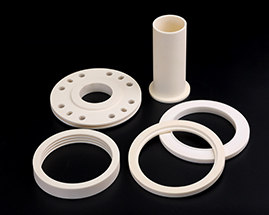Ceramic products are divided into two categories: ordinary ceramics and advanced ceramics. Among them, advanced ceramics, also known as new ceramics,
fine ceramics, high-tech ceramics, etc., refer to ceramics that use high-purity, ultrafine artificially synthesized or selected inorganic compounds as raw materials,
have precise chemical composition, precise manufacturing and processing technology, and structural design, and have excellent mechanical, acoustic, optical,
thermal, electrical, biological and other characteristics. They can be seen everywhere in the fields of aerospace, electronic information, biomedicine, high-end
equipment manufacturing, and other technological fields.
We compare the above two types of ceramics from the following aspects:
1.Raw Materials & Composition
Traditional ceramics usually use natural mineral raw materials, mainly clay and porcelain stone.
The raw materials of advanced ceramics are artificially refined and synthesized, mainly consisting of oxides, carbides, nitrides, etc. The purity and process of
the raw materials determine the properties of advanced ceramics.
2.Processing Technology
The processing technology of traditional ceramics includes crushing, grinding, blending, shaping, drying, forging, etc., mainly through injection molding and
plastic forming, and the sintering temperature is generally below 1350 degrees Celsius.
Advanced ceramics adopt more precise control advanced processes, such as isostatic pressing, injection molding, vacuum sintering, hot pressing, reaction
sintering, etc. The sintering temperature is usually higher, requiring precise temperature control, and after sintering, further processing such as cutting, punching,
grinding, and polishing is usually required.
3.Performance Differences
Traditional ceramics mainly focus on appearance, such as ceramic ornaments, whose performance mainly depends on the raw materials and firing process.
Advanced ceramics prioritize internal quality, with advantages such as low density, high hardness, stable chemical properties, good wear resistance, as well as
good conductivity, magnetism, optical properties, and more diverse colors.
4.Application Field
Traditional ceramics are often used for daily and architectural purposes, such as tableware, decorations, etc.
Advanced ceramics are widely used in petroleum, chemical, steel, electronics, textiles, automobiles, aerospace, nuclear industry, and cutting-edge technology
fields, such as insulation ceramics, wear-resistant ceramics, semiconductor ceramics, etc.
5.Technical Requirement
The production technology requirements for traditional ceramics are relatively mature, and the process flow is relatively fixed.
The production of advanced ceramics requires high technical requirements and precise control of chemical composition and process flow to meet specific
performance requirements.
In summary, traditional ceramics and advanced ceramics are different in many aspects. Advanced ceramics, with their excellent performance and wide application
fields, have become indispensable materials in the development of modern technology.

If you have any questions or need help, feel free to contact with our team.
Phone
+86 183 5248 9056
Location
Qianluo Village, Dingshu Town, Yixing City, Jiangsu Province, China
Welcome to subscribe to our email message!


Copyright © Yixing Shengda Refractory Ceramic Co., Ltd. All Rights Reserved | Sitemap | Powered By 